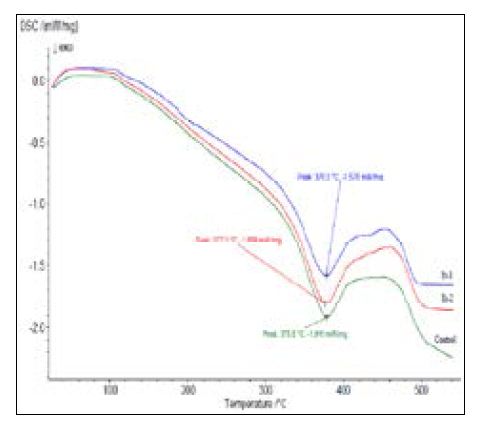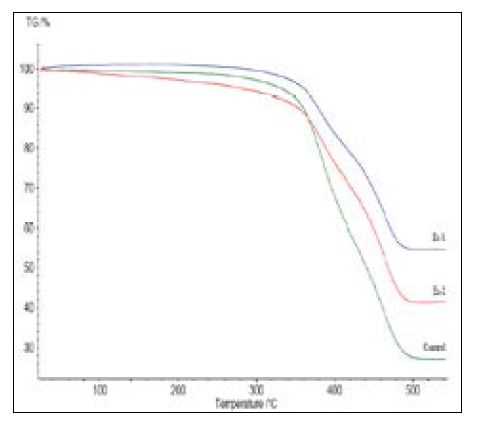Abstract
The main objective of this study was to determine the inorganic elemental components and thermal behavior of rubber samples collected from crime scenes and to compare them with a control sample.
Thermal decomposition study revealed that decomposition temperature of rubber samples by thermo-gravimetric analysis (TGA) collected from crime scene exhibit 1 and 2 were consistent with decomposition temperature of control rubber sample exhibit 3.
The differential scanning calorimetry (DSC) analysis showed that the decomposition temperature of the two rubber samples (exhibits 1 and 2) were 378.3 and 377.1oC, respectively, consistent with that of the control sample exhibit 3 (378.8oC). The micro Xray fluorescence (XRF) analysis showed that elemental composition of rubber samples Eexhibits 1 and Exhibit 2 matched with that of control sample Exhibit 3.
Thermal analysis was shown to be an important tool for characterizing the thermal behavior of rubber samples. Comparison of rubber samples collected from the crime scene with the reference rubber sample from the suspect’s vehicle can be an valuable objective evidence.
Introduction
Thermal analysis (TA) methods have been extensively used to characterize polymeric materials in last few decades. Thermometry and thermodynamics are the basic principles of thermal analysis [1-2]. Thermometry is used for measurement of temperature in the study of phase transition, while thermodynamics is used to study kinetic parameters of a reaction [3-6]. Basically, thermal analysis is commonly used to study the thermal changes in polymeric material when it is heated and cooled. Thermal analysis includes thermogravimetric analysis (TGA), differential thermal analysis (DTA), differential scanning calorimetry (DSC), evolved gas analysis (EGA) and thermomechanical analysis (TMA). A DTA technique involves the measurement of temperature difference between a substance and reference material. The difference in energy inputs into the substance and reference material is measured in DSC techniques. A TGA technique involves change in the mass of samples and is measured as a function of temperature. In EGA analysis, the nature and amount of volatile substance(s) released by a sample is measured as a function of temperature. Thermal analysis techniques are used to analyze soil, paint and fibers, etc.
Thermal analysis methods have been frequently used in the field of forensic sciences. Machenzie and Theophrastus used thermal analysis technique to study the effect of heat on different minerals [7]. Liesztner used thermal analysis in the field of forensic science for analysis of paint samples [8]. The application of thermal analysis of fibers has been well discussed in a review [9].
The challenges facing forensic experts are to examine traces of chemicals, as well as polymeric material such as paint, rubber and plastic. These materials are encountered in the human environment in the form of tyres, shoe soles, plastic handles and grips. The forensic experts are asked to match the chemical composition of control material with that of the material collected from the scene of a crime. In such cases, comparative physico-chemical analysis is carried out to check the degree of similarity in chemical composition between the material recovered from the crime scene and a control sample. Lachowicz et al. 2012, reported analysis of rubber samples by pyrolysis-gas chromatography [10]. Recently, Gueissaz and Massonnet described a methodology for the chemical analysis and composition of tire and tire thread samples by pyrolysis-gas chromatography/mass spectroscopy technique [11]. One of the most important tools, thermogravimetric analysis (TGA), is used for quantitative analysis of rubber vulcanisates and their additives.
In this study, we received two pieces of rubber collected from a crime scene and one rubber piece as a control sample. Initially, the rubber samples were analyzed by micro-XRF to know the elemental composition of rubber samples. We also carried out thermal analysis, i.e. TGA and DSC of these rubber samples to know the decomposition temperature of rubber samples.
Case report
Rash driving and driving under the influence of drugs has been gradually increasing in India. India has seen recent advances in traffic safety; however, driving under influence of drugs still remains a persistent problem in traffic safety. In hit and run cases, analysis of debris left at the scene of the crime like plastics, rubber and rubber like parts may lead to recognize the type of offending vehicle. We received a case, in which a sand loaded vehicle hit a man riding on a bike. From the scene of the crime, rubber (tire) samples were collected by the investigating officer (police authority) and sent to the forensic laboratory for further rubanalysis.
After investigation, the said vehicle was seized from the accused and rubber samples were collected from the vehicle’s intact tire as a control sample and sent to the laboratory for rubber comparison. The thermoanalytical methods are used to examine various materials collected from the vehicle involved in the criminal offence.
Results and Discussion
| Sample code | T (oC) DSC | T* (oC) TGA | Residue left (%) | |
| Start (%loss) | End(%loss) | |||
| Ex-1 | 378.3 | 378.1 (3.7) | 494.2(45.29) | 54.7 |
| Ex-2 | 377.1 | 377.4(5.3) | 494.6(58.5) | 41.5 |
| Ex-3 | 378.8 | 378.2(4.1) | 494.1(72.2) | 27.0 |
Table 1- Decomposition temperature values of rubber samples by DSC and TGA.
Thermogravimetric analysis is an important method that shows the thermal stability of materials. Also, the profile of decomposition process and yield of the material associated with the thermal treatment can be obtained. TGA and DTG analysis of rubber samples was carried out using a simultaneous thermal analysis STA 449 F3 Jupiter instruments analyser, using alumina pans (5-10 mg), under nitrogen atmosphere (60 mL/min) at heating rate of 10oC/min to determine thermal stability and char yield. The decomposition temperature of rubber samples determined from DSC and TGA are presented in Table-1. Figure-1 & 2 represent the DSC and TGA plots, respectively, of the rubber samples. The DSC results for degradation of rubber samples are summarized in Table-1. As shown in Table-1, Exhibit 1 and 2 had decomposition temperatures of 378.3 and 377.1oC, respectively, while that of exhibit 3 was 378.8oC. The decomposition temperature of rubber samples collected from the crime scene (Exhibit 1 and 2) matches with that of the control sample (Exhibit 3). The results showed the difference in the values of total weight loss mass due to different initial mass of samples taken for analysis.
 |
 |
||||||
| Figure 1- DSC curves of rubber samples (Exhibit 1, 2 and control). | Figure 2- TGA curves of rubber samples (Exhibit 1, 2 and control). |
The thermal decomposition of rubbers is evaluated by measuring the weight loss with constant rise in temperature. The decomposition temperature is the temperature at which maximum weight loss occurs in a sample. Table-1 summarizes decomposition temperatures of rubber samples studied by TGA. The decomposition temperature of rubber samples collected from the crime scene (Exhibit 1 and 2) are 438.7and 437.3oC, respectively, while decomposition temperature of control rubber sample Exhibit 3 is 438.5 oC. The results show good agreement between decomposition temperatures of Exhibit 1 and 2 with that of exhibit 3.
Figure 3- Elemental composition of rubber samples (Exhibit 1, 2 and control).
The determinations of inorganic elemental components were performed using micro energy dispersive X-ray fluorescence, XGT-7200V, Japan. The micro-XRF analysis of rubber samples is shown in Figure-3. The result revealed the presence of inorganic components like silica (Si), sulfur(S) calcium (Ca) and zinc (Zn). In the rubber industry, silica is used as reinforcing filler, having a specific surface area of 25-250 m2/g. Two types of silica’s used in the rubber industry are precipitated silica and pyrogenic silica.
Rubber industries replaced carbon black by silica because of the improved mechanical properties of rubber like tear, abrasion, heat resistance, flex stability, hardness, stiffness and modulus and many more [12]. In the tire industry, silica is used in combination with styrene-butadiene rubber to reduce the rolling resistance by 30%.
The vulcanization process is carried out by using sulfur as a vulcanizing agent to create a rubber network/polymer from the separate rubber macromolecules. The vulcanization reaction in presence of sulfur proceeds slowly. Hence, zinc oxide (ZnO) is used as activator to speed-up the reaction [12]. For this purpose, zinc oxide is made soluble by adding fatty acids like steric acid. Also, ZnO enhances the thermal stability of rubber vulcanizates. Along with reinforcing fillers, a wide range of non-reinforcing fillers are used. The most common filler used for this purpose is calcium carbonate [12]. Calcium carbonate has semi-reinforcing effect. From the results obtained from micro-XRF, it can be concluded that elemental composition of recovered samples (Exhibit 1 and 2) tallies with that of control sample (Exhibit 3).
Conclusion
Thermal analysis was shown to be an important tool for characterizing the thermal behavior of rubber samples. The results of thermal analysis indicate that decomposition temperature of rubber samples collected from the crime scene (Exhibit 1 and 2) tallies with that of the control rubber sample (Exhibit 3). The inorganic elemental content of rubber samples in Exhibit 1 and 2 matches with that of exhibit 3. In this study, a comparison between rubber samples collected from the scene of the crime with the rubber sample from the suspect’s vehicle can prove very valuable objective evidence.
Acknowledgement
The authors thank the Director of Directorate of forensic sciences, Mumbai for his support and encouragement. The authors also thank Mr. Brahmanand Kamble and Mrs. Swati Gaikwad for cooperation during analysis.
References
1. Brown M, Introduction to Thermal Analysis: Techniques and Applications, Chapman & Hall, London, 1988.
2. Turi E, Thermal Characterisation of Polymeric Materials, Academic Press Ltd, London, volume 2, 1997.
3. Raudino A, Sarpietro MG, Pannuzzo M. The thermodynamics of simple biomembrane mimetic systems. J Pharm Bioallied Sci. 2011;3(1):15.
4. Islam SZ, Deshmane VG, Ilias S. Thermal stability study of Pd-composite membrane fabricated by surfactant induced electroless plating (SIEP). Sep Sci Technol. 2016;51(7):1176-88.
5. Reinert JC, Steim JM. Calorimetric detection of a membrane-lipid phase transition in living cells. Sci. 1970;168(3939):1580-2.
6. Melchior DL, Morowitz HJ, Sturtevant JM, Tsong TY. Characterization of the plasma membrane
of Mycoplasma laidlawii. VII. Phase transitions of membrane lipids. Biochim Biophys Acta, Rev Biomembr. 1970;219(1):114-22.
7. Miller B, Thermal Analysis (Proceedings of the 7th ICTA: Ontario, 1982).2 Vol. John Wiley & Sons, Chichester, New York, 1982.
8. Hellmiss G. Thermal analysis methods in forensic science. In Forensic Science Progress 1988 (pp. 1-30). Springer, Berlin, Heidelberg.
9. Harmon JP. Thermal Analysis of Polymeric Materials By Bernhard Wunderlich (Knoxville, TN). Springer: Berlin, Heidelberg, New York. 2005. xvi+ 894 pp. $89.95. ISBN 3-540-23629-5.
10. Lachowicz T, Zięba-Palus J, Kościelniak P. Analysis of rubber samples by Py-GC/MS for forensic purposes. Problems of For Sci. 2012;91:195-207.
11. Gueissaz L, Massonnet G. Chemical analysis of tire traces in traffic accidents investigation. J Forensic Sci Med. 2015;1(2):99.
12. Wilma D, Raw materials and compounds in rubber industry. University of Twente, 2007.